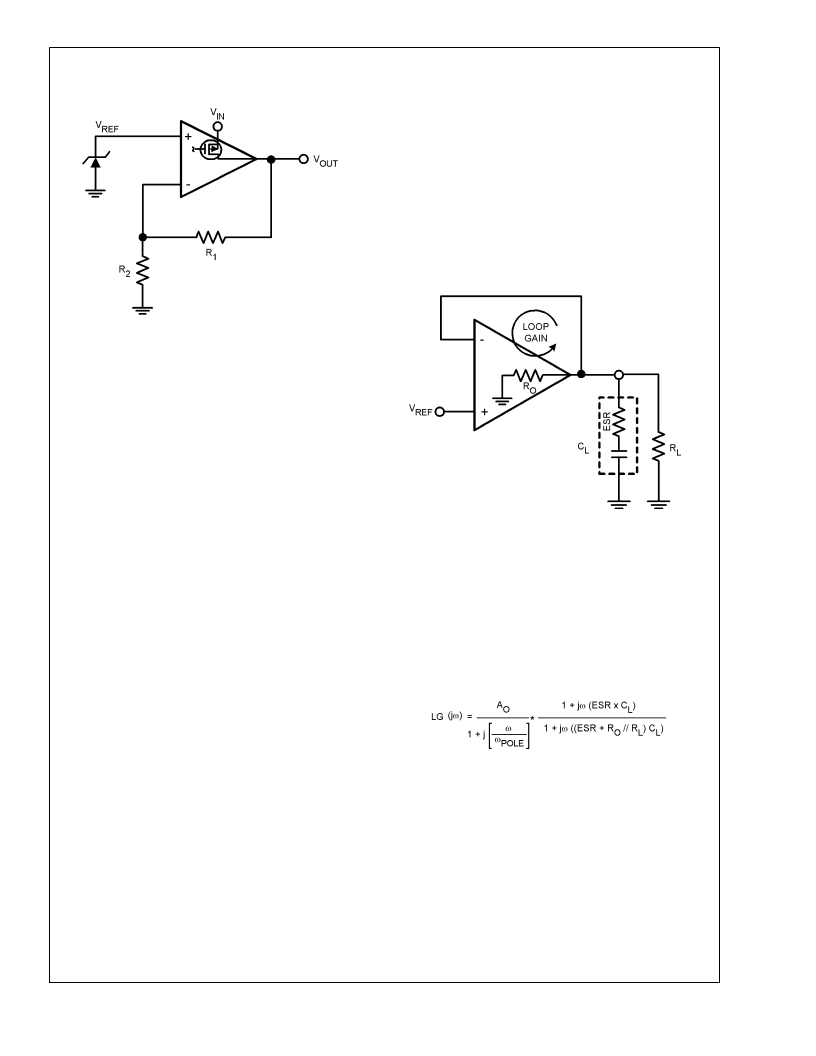- 您現(xiàn)在的位置:買賣IC網(wǎng) > PDF目錄361045 > LP3982ILDX-2.82 (NATIONAL SEMICONDUCTOR CORP) Micropower, Ultra Low-Dropout, Low-Noise, 300mA CMOS Regulator PDF資料下載
參數(shù)資料
| 型號: | LP3982ILDX-2.82 |
| 廠商: | NATIONAL SEMICONDUCTOR CORP |
| 元件分類: | 基準(zhǔn)電壓源/電流源 |
| 英文描述: | Micropower, Ultra Low-Dropout, Low-Noise, 300mA CMOS Regulator |
| 中文描述: | 2.82 V FIXED POSITIVE LDO REGULATOR, 0.22 V DROPOUT, DSO8 |
| 封裝: | LLP-8 |
| 文件頁數(shù): | 7/12頁 |
| 文件大?。?/td> | 361K |
| 代理商: | LP3982ILDX-2.82 |

Application Information
(Continued)
Similarity in the output capabilities exists between op amps
and linear regulators. Just as rail-to-rail output op amps
allow their output voltage to approach the supply voltage,
low dropout regulators (LDOs) allow their output voltage to
operate close to the input voltage. Both achieve this by the
configuration of their output transistors. Standard op amps
and regulator outputs are at the source (or emitter) of the
output transistor. Rail-to-rail op amp and LDO regulator out-
puts are at the drain (or collector) of the output transistor.
This replaces the threshold (or diode drop) limitations on the
output with the less restrictive source-to-drain (or V
SAT
) limi-
tations. There is a trade-off, of course. The output imped-
ance become significantly higher, thus providing a critically
lower pole when combined with the capacitive load. That’s
why rail-to-rail op amps are usually poor at driving capacitive
loads and recommend a series output resistor when doing
so. LDOs require the same series resistance except that the
internal resistance of the output capacitor will usually suffice.
Refer to the output capacitance section for more information.
Output Capacitance
The LP3982 is specifically designed to employ ceramic out-
put capacitors as low as 2.2μF. Ceramic capacitors below
10μF offer significant cost and space savings, along with
high frequency noise filtering. Higher values and other types
and of capacitor may be used, but their equivalent series
resistance (ESR) should be maintained below 0.5
Ceramic capacitor of the value required by the LP3982 are
available in the following dielectric types: Z5U, Y5V, X5R and
X7R. The Z5U and Y5V types exhibit a 50% or more drop in
capacitance value as their temperature increases from 25C,
an important consideration. The X5R generally maintain their
capacitance value within
±
20%. The X7R type are desirable
for their tighter tolerance of 10% over temperature.
Ceramic capacitors pose a challenge because of their rela-
tively low ESR. Like most other LDOs, the LP3982 relies on
a zero in the frequency response to compensate against
excessive phase shift in the regulator’s feedback loop. If the
phase shift reaches 360 (i.e.; becomes positive), the regu-
lator will oscillate. This compensation usually resides in the
zero generated by the combination of the output capacitor
with its equivalent series resistance (ESR). The zero is
intended to cancel the effects of the pole generated by the
load capacitance (C
L
) combined with the parallel combina-
tion of the load resistance (R
L
) and the output resistance
(R
O
) of the regulator. The challenge posed by low ESR
capacitors is that the zero it generates can be too high in
frequency for the pole that it’s intended to compensate. The
LP3982 overcomes this challenge by internally generating a
strategically placed zero.
Figure 3
shows a basic model for the linear regulator that
helps describe what happens to the output signal as it is
processed through its feedback loop; that is, describe its
loop gain (LG). The LG includes two main transfer functions:
the error amplifier and the load. The error amplifier provides
voltage gain and a dominant pole, while the load provides a
zero and a pole. The LG of the model in
Figure 3
is described
by the following equation:
The first term of the above equation expresses the voltage
gain (numerator) and a single pole role-off (denominator) of
the error amplifier. The second term expresses the zero
(numerator) and pole (denominator) of the load in combina-
tion with the R
O
of the regulator.
Figure 4
shows a Bode plot that represents a case where the
zero contributed by the load is too high to cancel the effect of
the pole contributed by the load and R
. The solid line
illustrates the loop gain while the dashed line illustrates the
corresponding phase shift. Notice that the phase shift at
unity gain is a total 360 -the criteria for oscillation.
20036916
FIGURE 2. Regulator Topology Simplified
20036917
FIGURE 3. Simplified Model of Regulator
Loop Gain Components
L
www.national.com
7
相關(guān)PDF資料 |
PDF描述 |
|---|---|
| LP3982ILDX-3.0 | Micropower, Ultra Low-Dropout, Low-Noise, 300mA CMOS Regulator |
| LP3982ILDX-3.3 | Micropower, Ultra Low-Dropout, Low-Noise, 300mA CMOS Regulator |
| LPC660IM | Low Power CMOS Quad Operational Amplifier |
| LPC660IN | Low Power CMOS Quad Operational Amplifier |
| LPC660 | Low Power CMOS Quad Operational Amplifier |
相關(guān)代理商/技術(shù)參數(shù) |
參數(shù)描述 |
|---|---|
| LP3982ILDX-3.0 | 功能描述:低壓差穩(wěn)壓器 - LDO RoHS:否 制造商:Texas Instruments 最大輸入電壓:36 V 輸出電壓:1.4 V to 20.5 V 回動電壓(最大值):307 mV 輸出電流:1 A 負(fù)載調(diào)節(jié):0.3 % 輸出端數(shù)量: 輸出類型:Fixed 最大工作溫度:+ 125 C 安裝風(fēng)格:SMD/SMT 封裝 / 箱體:VQFN-20 |
| LP3982ILDX-3.0/NOPB | 功能描述:低壓差穩(wěn)壓器 - LDO RoHS:否 制造商:Texas Instruments 最大輸入電壓:36 V 輸出電壓:1.4 V to 20.5 V 回動電壓(最大值):307 mV 輸出電流:1 A 負(fù)載調(diào)節(jié):0.3 % 輸出端數(shù)量: 輸出類型:Fixed 最大工作溫度:+ 125 C 安裝風(fēng)格:SMD/SMT 封裝 / 箱體:VQFN-20 |
| LP3982ILDX-3.3 | 功能描述:低壓差穩(wěn)壓器 - LDO RoHS:否 制造商:Texas Instruments 最大輸入電壓:36 V 輸出電壓:1.4 V to 20.5 V 回動電壓(最大值):307 mV 輸出電流:1 A 負(fù)載調(diào)節(jié):0.3 % 輸出端數(shù)量: 輸出類型:Fixed 最大工作溫度:+ 125 C 安裝風(fēng)格:SMD/SMT 封裝 / 箱體:VQFN-20 |
| LP3982ILDX-3.3/NOPB | 功能描述:低壓差穩(wěn)壓器 - LDO RoHS:否 制造商:Texas Instruments 最大輸入電壓:36 V 輸出電壓:1.4 V to 20.5 V 回動電壓(最大值):307 mV 輸出電流:1 A 負(fù)載調(diào)節(jié):0.3 % 輸出端數(shù)量: 輸出類型:Fixed 最大工作溫度:+ 125 C 安裝風(fēng)格:SMD/SMT 封裝 / 箱體:VQFN-20 |
| LP3982ILDX-ADJ | 功能描述:低壓差穩(wěn)壓器 - LDO RoHS:否 制造商:Texas Instruments 最大輸入電壓:36 V 輸出電壓:1.4 V to 20.5 V 回動電壓(最大值):307 mV 輸出電流:1 A 負(fù)載調(diào)節(jié):0.3 % 輸出端數(shù)量: 輸出類型:Fixed 最大工作溫度:+ 125 C 安裝風(fēng)格:SMD/SMT 封裝 / 箱體:VQFN-20 |
發(fā)布緊急采購,3分鐘左右您將得到回復(fù)。
